The Center for Student Diversity & Inclusion (CSDI) debuted on campus at the beginning of the semester since the reconfiguration of its office over the summer. The new office, formerly known as the Office of Diversity Affairs (ODA), combines various multicultural spaces into one space in order to collaborate more effectively.
The changes began last semester, combining the Cultural Center, the Women*s Center and LGBTQ+ Services into one space on the second floor of the Armstrong Student Center (ASC). With these offices in close proximity to one another, students who may identify with more than one underrepresented group can utilize the services as they see fit.
“I think, historically, the Cultural Center, now Center for Student Diversity and Inclusion, was a space that served particularly black students. But I would say that this change is more encompassing of what their department is supposed to serve as,” Student Body President Jaylen Perkins said. “That is much more than just the black experience, the black student experience. I think it's essential for students to have their own ideal space, but I think it's just a matter of navigating that space to be [cultivated] for everyone.”
Prior to the construction of CSDI, the Office of Diversity Affairs served predominantly as a hub for African-American students on campus. The Women*s Center and LGBTQ+ Services occupied an office on the third floor of ASC. However, Director of the Women*s Center Jane Goettsch said that those locations were only temporary. The plan to combine the offices had been in the works since the arrival of the Director of the CSDI, Kelley Kimple, in 2016.
Goettsch says CSDI wanted to create a more robust and integrated department with a focus on Diversity and Inclusion. She likes the new changes and thinks they are something that students will have to get used to. She is also excited about what the office will do for new students.
“New students don’t know any different,”Goettsch said. “But, of course, for students who have returned, it is different from what they’re used to. Sometimes it just takes some adjusting.”
When students returned to campus and saw the new center, mixed feelings about the changes were brought to the forefront. Some students feel that the combination of the offices robs students of a singular place to call their own.
“I definitely applaud the office for trying to include everyone in one space and really highlight on intersectionality. Though, I also would be remiss if I didn’t acknowledge that it is difficult for different groups to not have a space they can call their own,” said Brandon Small, Associated Student Government (ASG) secretary for diversity and inclusion.
Some returning students were unsure how they would feel about the new space, but it has since grown on them.
“At first, I was hesitant to see how the culture was going to react to it,” said Diversity Affairs Council (DAC) President Jannie Kamara. “Now that I’ve been there a couple times, I do like the community. There still is this space where people feel they can have their own sense of community but also feel connected.”
CSDI has acknowledged that its office does not serve every underrepresented group on campus and is working toward a solution.
“[We are] trying to figure out where are those other campus partners that we’re able to connect with, in order to ensure we are having broader representation across the campus,” Kimple said during the “Voices of Love & Honor” inclusion forum on Wednesday, Sept. 18. “We recognize that there are students we don't have the opportunity to serve at this point in time. That [is] something that we are working on.”
Enjoy what you're reading?
Signup for our newsletter
In an attempt to reach more students, CDSI has begun the process of constructing a lounge area on the third floor of Armstrong to give students a place to go after the offices close at 5 p.m. The area will serve as an office for DAC but will also include a study space, meeting room and computer station. Card access to the third floor lounge will begin at 11 p.m., but students who were already in the office are allowed to stay there until Armstrong closes at 2 a.m.
This lounge will also allow students from many other underrepresented groups who do not have a designated place in CSDI find a sense of community.
The transition for all students hasn’t been easy, but Goettsch wants students to feel comfortable expressing their concerns with every member in the office.
“It is our responsibility as staff to acknowledge [student concerns]. What can we do to get as much [of] that feeling back, but in a different space?” Goettsch said. “We are all very interested [in] hearing students’ impressions, and we acknowledge and have always known that there would be an adjustment period. Tell us what in this new configuration will help them feel like this is the home that they remember.”




